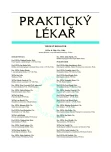-
Medical journals
- Career
Food-borne infections and intoxications
Authors: V. Bencko 1; M. Príkazská 2
Authors‘ workplace: Ústav hygieny a epidemiologie 1. LF UK, Praha Přednosta: doc. MUDr. Milan Tuček, CSc. 1; Státní zdravotní ústav, Praha Odbor epidemiologie infekčních nemocí Vedoucí: MUDr. Jitka Částková, CSc. 2
Published in: Prakt. Lék. 2010; 90(5): 274-278
Category: Reviews
Overview
The most common food-borne infections in the Czech Republic are salmonellosis and campylobacteriosis. The number of reported salmonellosis cases has declined in recent years, while campylobacteriosis has been reported with increasing frequency since 1985 and has become the leading intestinal disease in many European countries. The highest age-specific incidence rates of salmonellosis have been observed in 0 and 1–4 year-old outpatients and in older hospitalised patients with other underlying diseases. The most frequent causative agent is Salmonella Enteritidis. The suspected vehicle can be best traced in outbreaks. Most Salmonella outbreaks are associated with collective catering (school and business canteens, etc.) and family celebrations where home-made pastries and specialities and products containing eggs and mayonnaise are commonly served.
Campylobacteriosis, which is most frequently caused by Campylobacter jejuni, has shown the greatest increase in the youngest age groups (0 and 1–4-year-olds), which suggests poorer hygiene in food processing and handling (particularly in households). The most commonly suspected vehicles of infection are chicken and minced meat.
Recently, attention has been paid to listeriosis cases and outbreaks. A relatively high fatality rate of 20–30 % has been reported in immunocompromised individuals (patients with other underlying diseases such as malignancies and immunosuppressed patients), particularly in higher age groups.
In the Czech Republic, an increase in hepatitis E following a primary food-borne infection has been observed, independently of imported sources. Food-borne viral infections have also shown an upward trend. Bacterial food intoxications included in food-borne infections are caused by toxin producers, with botulinum toxin and toxins produced by some strains of golden Staphylococcus being clinically most important.Key words:
food-borne infections, food-borne intoxications, bacterial toxins, salmonellosis, campylobacteriosis, listeriosis, epidemiologic aspects
Sources
1. Bencko, V., Kudlová, E. Alimentární infekce a intoxikace bakteriálními toxiny. In: Kudlová, E. a kol. Hygiena výživy a nutriční epidemiologie. Praha: Nakladatelství Karolinum, 2009, s. 242-250.
2. European health for all database. WHO/EUROPE [on-line]. Dostupné na http://www.euro.who.int/ hfadb. (Navštíveno 14.5.2010)
3. Food and health in Europe: a new basis for action. Copenhagen: World Health Organization, Regional Office for Europe, 2003, 30 s.
4. Food-borne disease: a focus for health education. Geneva: Word Health Organization, 1999.
5. Pazderková, J., Sajbertová, J., Dlouhý, P. a kol. Rodinný výskyt hepatitidy typu E v důsledku primární alimentární infekce. Prakt. lék., 2009, 89, č. 5, s. 265-267.
Labels
General practitioner for children and adolescents General practitioner for adults
Article was published inGeneral Practitioner

2010 Issue 5-
All articles in this issue
- Assessment of surrogate family care applicants’ health status
- The impact of a movement intervention program on functional self-sufficiency and manual dexterity of older adults living in homes for the elderly
- Prevention of inflammatory complications of cataract operations – results of a clinical trial of levofloxacin topical use
- Evaluation of risk factors in the working environment and occupational diseases
- Needs of ADHD families
- Does bisexuality exist?
-
Evoluce a evoluční teorie pro lékaře
V. Darwinovy teorie evoluce - Food-borne infections and intoxications
- Occupational diseases reported in the Czech Republic in 2009
- Effective hemostasis in bloodless surgery-review
- General Practitioner
- Journal archive
- Current issue
- Online only
- About the journal
Most read in this issue- Food-borne infections and intoxications
- Does bisexuality exist?
- Effective hemostasis in bloodless surgery-review
- Assessment of surrogate family care applicants’ health status
Login#ADS_BOTTOM_SCRIPTS#Forgotten passwordEnter the email address that you registered with. We will send you instructions on how to set a new password.
- Career

